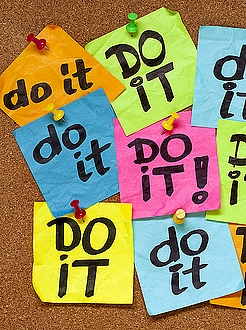Attention Deficit Trait : Multitasking Managers Under Performing
If you are a slave to your emails, text messages, iPhone, BlackBerry or Android Mobile Device and you have trouble
coping with multitasking and distractions you may be suffering from the growing problem of
Attention Deficit Trait (ADT). In some ways it is related to Attention Deficit
Hyperactivity Disorder (ADHD), which is mostly seen in children but can also occur in adults.
The better known ADHD condition in children, is characterized by hyperactivity,
impulsiveness and inattention. Research has shown that these ADHD symptoms continue into adulthood for about
60% of children, who suffer from this affliction.
On the other hand Attention Deficit Trait (ADT)
is purely environmental and is fixable. It appears to be related to an inability to cope with all the myriad of distractions
that bombard our brains as a result of email, texting, phone calls and other social networking sources.
Multitasking can be done by computer chips and computers but most humans make a mess of it as they lack this ability.
Attention Deficit Trait is a symptom of modern managers inability to cope with multiple simultaneous distractions cause by social
media and deal with multiple tasks. Attention Deficit Trait is rotting fine young smart manager's brains and causing them
to under perform at work.


ADT is characterised by
- a sense panic and inner frenzy,
- distractibility,
- stress
- failure to concentrate or focus
- impatience,
- obsessive desire for distractions to avoid the hard tasks
- poor planning
- failure to step-back and refocus the perspective
- poor performance of tasks.
ADT can turn smart gifted managers into under performing zombies as it prevents managers from clarifying priorities, making intelligent and considered decisions, planning ahead and managing their time. There is concern that ADT is reaching epidemic proportions. It is likely to get worse because there is evidence that young people's brains are being altered by texting and social media.
Contrast this with the characteristics of Successful Managers
- Having a Vision and Setting goals all the time - Goals are the steps that moves a company up towards to its vision. These goals must be reformulated and checked frequently. The first step is the creation of the overall vision. Then there are a set of goals - a long term goal, annual and monthly goal, goals for each member staff to achieve to define their role in achieving the vision. This defines a clear picture of where the company is headed in terms of its employees, customers, performance, work environment and culture.
- Focus on the adaptable processes, to achieve the plan
- Coach and develop the right people and delegate to the right people who can achieve the tasks.
- Empower your entire team to avoid micro-management. This involves risks but has many rewards. Managers should sets clear goals and clear boundaries.
- Do all the right things well
How Does ADT Develop?
Mostly the symptoms of ADT develop gradually. People under stress start to under perform, not due to a single crisis, but to a string of minor emergencies or problems. The person tries harder and harder to respond to the series of hot urgent issues and can't cope with the stream new ones that pour in all the time. Instead of stepping back and taking a distant view to prioritize, delegate and deal with the flood, they adopt a frenzied approach as the workload increases and all or their work suffers.
Smart managers develop ways of coping with this, but the younger generation who have grown up under constant distraction don't seem to have the ability to cope with the myth of multi-tasking properly.
How to Step Back and Reorganize your Brain and Priorities
ADT prevention requires managers to regularly step back and switch-off the bombardment from the social media and communication, and to switch their approach from "survival mode," to "Planning and prioritizing" mode. They need to switch from reactionary approaches - always trying to deal with the 'spot fires', to long term goal setting and planning.
Steps to combat ADT:
Step 1 - Think positively and look forward - A mind that is cluttered with multi -tasks causing stress is clouded by negative emotions, fear of failure and the constant stress of not being able to cope. "I have to do this, I have to do that, what about that, this is due now". This jumble and clutter wastes time. Thinking more positively, developing a list and planning can help a lot.
Step 2 - Avoid the sense of Isolation and Bunkering Down to get things done -Switching off your social interactions to devote yourself to the pile of jobs and emails may work or a short time, but it becomes self-defeating over a long period of time. Try to interact with people you like every 4 - 6 hours. Take regular breaks - you will often be very surprised how taking a break puts things into perspective again and leads to solutions and better ranking of things to do. People who work by themselves, in isolation and switch off from the colleagues, are more likely to develop ADT.
Step 3 - Prioritise by developing a list - This sounds so simple but it is remarkable effective. Write down each of your tasks on sticky-notes. Pick them up one at a time in rank order with the most important at the top. Doing this does several things:
- You know you have compiled a list and so you don't have to have them all running around in our brain. The mere act of writing done your tasks helps to clear the confusion. In your brain the tasks are confused and ill-defined - written down they have structure and boundaries - they are well defined. Writing then down clears your head
- Keep your list to 10, 15 items - you have set a limit. The rest can be written down and kept on piece of paper
- You only see the tasks one at a time - the top ranked one that is on top.
- As the tasks are completed you scrap the piece of paper
- If a new task comes up simply make a note and add it to the bottom
- If you have to re-assign our priorities - spread all the task out, add the new ones and re-rank them. BUT resist the temptation of making the list too big. Try to develop the idea of the limited list. Any new task can only be added by dropping one of the existing ones. You may need a second pile of sticky-notes for the ones you have dropped.
- Include a 'take a break' and 'time for a re-think" notes in your pile - say after every five tasks. Reward yourself with a break. Don't look at what you have to do next until you come back!
Step 4 - When you feel overwhelmed, or tired do a set of easy tasks. This will help you feel more able to take on the bigger and more complex tasks. Allocate the big complicated tasks to first thing in the morning or after lunch, or at other times when you know you will be at the 'peak of your game'. When you feel refreshed and can do a better job with them.
Step 5 - Learn to Delegate to your Employees strongest capabilities - If you are a manager, try to get employees focused on their strengths in doing delegated tasks. This boosts their efficiency and morale within an organisation and gets the job done. Delegating effectively will also improve the manager's performance.
Step 6 - Look after Yourself and Learn to Switch Off - Take care of yourself and make sure you get enough sleep, exercise regularly and eat healthfully. Whether it’s running, jogging, gym work, Aikido or dancing these activities force you engage your thinking on something else.
Step 7 - Go ALL IN on Commitments - Work, Play Family - One and a Time - for Set Amounts of Time - Most of the highlights and achievements have one feature in common - you went all in and devoted yourself to the goal with the exclusion of distractions. You committed 100% to the tasks, were fully engaged and were fully focused. Satisfaction requires your full, devoted and undivided attention. Nothing ruins your time with your family or social occasions like work distractions and interruptions. Many of these can be internally generated - "just thinking about work". Devoting full attention to things, engaging and focusing on one thing at a time are part of emotional intelligent and having a full life. Don't Live a HALF-LIFE.
Step 8 - Turn-Off the Interruptions - Don't be Instantly available all the time - Only check you email and phone messages every half an hour and turn off the instant notifications if you can. The urge to constantly check messages and to monitor them constantly is a telltale sign that the gadgets and messages are running you, instead of the other way around. in many ways Attention Deficit Trait is by-product of and overworked and scrabbled brain that can't handle all the distractions and multi-tasks. This causes distractibility, panic, impatience and in some ways a love of being disturbed because the ability to focus and concentrate has been lost. Only check your phone, text messages and emails every half an hour or so and switch them to silent mode and recording mode.
Step 9 - Learn to Multi-Task Properly - Our brains and the way we think needs boundaries and despite all the claims about multitasking can only do one thing at time. In a given day an average person may check text and phone messages about 50-100 times and day and many managers may receive more than 100 emails. Some teenagers text more than 700 messages a day. Every time your brain stops one task and shifts to another, it takes a while to adapt to the change. Often there is a carry over. You end up thinking about the last text message while trying to do something else. If there are five or more 'recent interruptions' running chaotically through your brains you are headed for ADT problems. So multitasking does not help you to accomplish more - it actually slows you down so you achieve less. Research studies have shown that multitasking is really a myth. You are not doing multiple tasks simultaneously. Just think how hard it is to pat your head and rub your tummy at the same time! In reality you have one thought process that you are switching rapidly back and forth between competing tasks. This destroys any focus and attention because there are always carry-overs from the last task that can't be switched off. So managers have to learn to go ALL-IN on one task at a time an do multiple tasks in a sequence - not at the same time.
Step 10 - Learn to Set Boundaries - Spaces in Time and Location - Setting boundaries in time and space helps you to achieve more, deliver better outcomes and to have more time for the other things in life - your family and social life. Boundaries also helps to rebuild focus and attention.
Conclusion
The good news is that ADT is not permanent and can be fixed by following the steps outlined. Turn-off the distractions, develop lists of tasks that you do one at a time with your complete attention and focus.